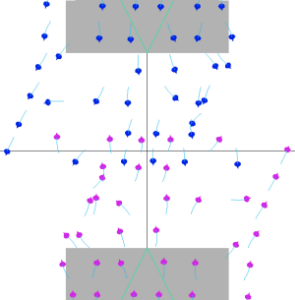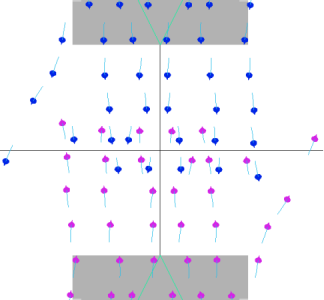Once the actor's basic collision avoidance settings are initialized in the Initialize Collision Avoidance compound (see Setting Up How Actors Avoid Collisions), you can determine the way in which an actor anticipates collisions with other actors and walls during the particle simulation.
When an actor "sees" one or more other actors or walls, several factors are considered to determine if a collision is imminent, as calculated in the Collision Avoidance node that's inside the Simulate Collision Avoidance compound:
After the ICE tree checks for imminent collisions, the actor's point position is updated and then its velocity and orientation is updated inside the Simulate Collision Avoidance compound.
You can set the actor's anticipation behavior with the Actor Avoidance parameters in the Simulate Collision Avoidance compound in the simulation point cloud's Particle Simulation ICE tree, as described here.
To open the property editor for this compound, you can choose the CrowdFX  Simulation
Simulation  Edit
Edit  Inspect Collision Avoidance command from the ICE toolbar.
Inspect Collision Avoidance command from the ICE toolbar.
There are two factors that you can set to alter the actor's behavior: Anticipation Factor and Anticipation Contrast.
The Anticipation Factor in the Set Velocity Using Collision Avoidance compound determines how soon the actor starts to turn away to avoid an imminent collision based on the time to collision. The amount that the actors turn at the beginning depends on the Anticipation Contrast value.
If the factor is a high value, the actor starts turning immediately after detecting an imminent collision (he's very cautious), as shown in the image below.

At a low value, the actor turns away only when he gets close to the moment of collision (he's living dangerously), as shown here.

The Anticipation Contrast in the Set Velocity Using Collision Avoidance compound is the contrast between how much the actor turns away versus how close he is to a collision.
A high contrast value makes the actor turn away sharply when he's close to a potential collision, as shown in the image below.

A low contrast value makes the actor turn away slightly when he's far away from collision, as shown here.

Remember that the angle range in which the actor is allowed to turn is defined by the Angular Velocity at Slow Speed/Target Speed parameters in the Initialize Collision Avoidance compound.
The Braking Threshold in the Set Velocity Using Collision Avoidance compound is the factor that determines when an actor starts to "put on the brakes" to avoid a collision. This value is the number of seconds. The lower this value, the closer the actor will get to having a collision before starting to slow down.
For example, if this value is 0.5, the actor starts to brake when he's within 0.5 seconds of colliding with another actor, as shown in the image below.

 Except where otherwise noted, this work is licensed under a Creative Commons Attribution-NonCommercial-ShareAlike 3.0 Unported License
Except where otherwise noted, this work is licensed under a Creative Commons Attribution-NonCommercial-ShareAlike 3.0 Unported License